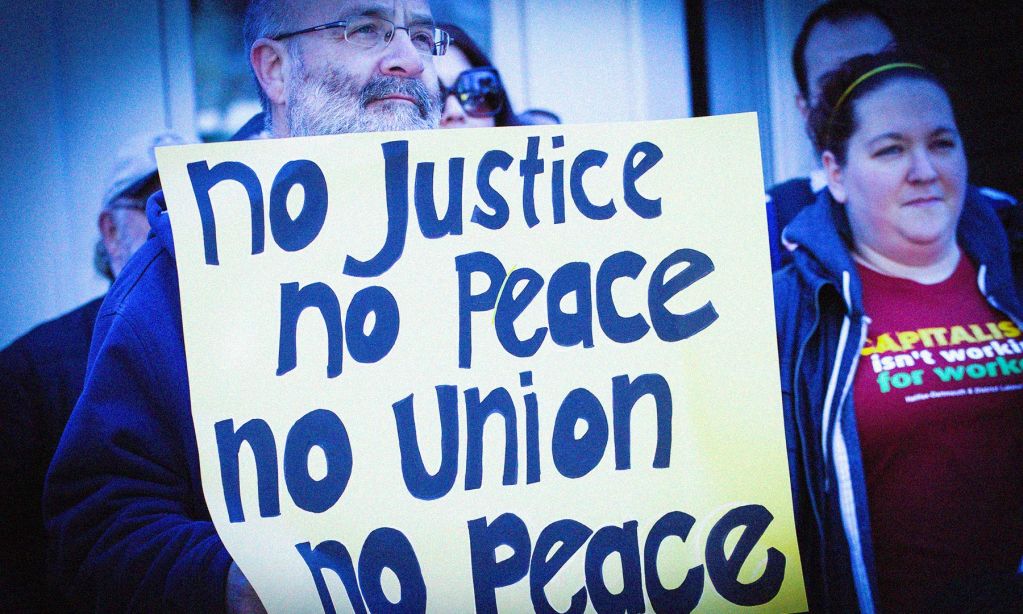The nineteenth-century Mexican politician, Porifirio Diaz, once lamentably described his country as being “so far from God” yet “so close to the United States.” In a different register, Canada’s proximity to the United States can, at times, feel like a comparable burden for those of us who wish to see better of this country. Things might be bad, but at least we’re not in America.
The fortunes of organized labour—and declining union density in particular—are an apt illustration of this “could be worse” posture.
American labour has taken a pummeling since the 1980s. The latest figures from the U.S. Bureau of Labor Statistics indicate that union density has fallen by half between 1983 and 2022. In the early 1980s, over 20 per cent of American workers belonged to a union. Last year, despite unions adding 273,000 new members, density continued its precipitous fall, dropping to 10.1 per cent from 10.3 per cent in 2021.1 Meanwhile, so-called “right-to-work” laws have eliminated union security and depressed wages in half of the country, including in the federal public sector.2 As a further sign of American labour’s weakness, major work stoppages now barely register. Whereas strikes and lockouts at large workplaces idled production 470 times in 1952, workers hit the picket line in “major work stoppages” just 23 times last year.3
Gazing south at this carnage can understandably leave Canadian labour advocates breathing a sigh of relief. But things are hardly rosy in Canada when it comes to the health of organized labour.
In November 2022, Statistics Canada released a report tracking unionization from 1981 to 2022.4 Far from a counter-narrative to the American story, the Canadian figures evince a similar rate of union decline. Over the last 40 years, union density in Canada has dropped by nine percentage points, going from a high of 38 per cent in 1981 down to 29 per cent last year. When only full-time jobs are included in the count, the fall is close to 11 per cent—greater than the American union slump.
Canadian labour’s relatively better position is largely maintained by the size and breadth of public sector unionization. At 77 per cent, public sector union membership is nearly universal for non-managerial employees. Moreover, women in the public sector are even more likely than their male counterparts to be union members.5
The fall in Canadian union coverage has, therefore, occurred entirely in the private sector. In this so-called “commercial sector,” union density has nearly halved, going from 29.7 per cent in 1981 to 15.2 per cent in 2022. Roughly two-thirds of this drop in unionization took place between 1981 and 1997, though private sector union density has continued its steady downward slide since.
Although falling union density in Canada is hardly news to those keeping a close eye on the Canadian labour market, connecting the predicaments of the present to long-term trends is both revealing and prescriptive. Identifying the sources of the problem points us in the direction of possible reform.
As Statistics Canada’s report points out, private sector union decline has been driven, in part, by deindustrialization and the changing composition of jobs. In other words, fewer jobs in union strongholds like manufacturing and resource extraction mean fewer union members. Service sector jobs, particularly those in retail and food and accommodation, have been and remain largely non-union.
However, industrial restructuring is only one side of the story. Within private sector industries—including manufacturing and resource extraction—union coverage has also dropped. Between the early 1980s and the late 1990s, union density fell between 13 and 19 percentage points among men in manufacturing, mining, forestry and construction. The economy was not simply shedding union jobs; employers were aggressively driving unions out of the jobs that remained.
Unionization also dropped among workers with and without a bachelor’s degree, a further indication that declining membership was not as concentrated among blue-collar men as the deindustrialization story emphasized.
While union density fell by 15.7 per cent among men without post-secondary education, it dropped 12.8 per cent for men with at least a bachelor of arts degree. Women with a bachelor’s degree also saw their unionization rate fall by 11.5 per cent between 1981 and 2022, though they remain the most likely group to be union members.
Industrial restructuring and employers’ anti-union crusades have combined to reconstitute a Canadian working class that is historically less protected and less organized. Unions’ ability to set high wages for members, as well as indirectly influence and improve the wages and working conditions of nonunion workers, has weakened considerably.
Post-pandemic inflation has starkly revealed the extent of labour’s structural ineptitude. While inflation averaged 6.8 per cent in 2022, average hourly wage growth trailed at 4.2 per cent.6 Meanwhile, union wage settlements in major contracts covering 500 workers or more averaged only 2.6 per cent in 2022.7
Settling for less than inflation when the latter is running around 2 per cent is tolerable, if inauspicious. When price increases are running at 40-year highs, such capitulation is devastating for workers’ standards of living.
Wage increases are not the only casualty of weak bargaining power, however. Because union members are more likely to enjoy workplace benefits, such as extended health insurance plans and pensions, fewer workers now retain such advantages. As well, the job security available to union members is afforded to a shrinking share of the labour force—a reality that became all too apparent during the worst days of the COVID-19 pandemic when unemployment spiked, particularly among the non-unionized.8
To reverse these troubling trends and rebuild working-class power in Canada, we need a combination of new organizing and policy reform. The two go hand-in-hand. Without a coordinated fight, labour has little hope of rebalancing the scales. But without changes to the laws and regulations governing labour and employment, organizing on its own will not be enough to build back Canadian union density.
We may be seeing the beginnings of such reform in British Columbia. Last June, the New Democratic Party in B.C. reintroduced “card-check” union certification, allowing a majority of workers who have signed union cards to form a bargaining unit without holding a labour board-supervised vote. This is a welcome reform worth celebrating—and one for which unions in B.C. and beyond have long been fighting.
The B.C. Labour Relations Board’s 2022 Annual Report shows that card-check is making a difference. Overall, union certification applications in B.C. increased 59.3 per cent year-over-year, going from 108 filed in 2021 to 172 filed in 2022. Notably, over 66 per cent of applications for new bargaining units occurred after card-check came into force in June 2022. The law appears to also be improving the success rate of union applications. In 2021, slightly more than 79 per cent of applications resulted in a union certification. Last year, 87 per cent of applications resulted in a new bargaining unit. Impressively, unions applied for certification with an average of 74 per cent of eligible workers’ support after the card-check law came into force.9
The news from B.C. is especially promising, given that the province has suffered the largest union decline in the country. While all provinces—with the exceptions of New Brunswick and Nova Scotia—saw union membership fall by roughly two to three per cent between 1997 and 2022, B.C. has the dubious distinction of leading the pack with a unionization decline of 6.8 per cent.10
How much card-check might contribute to reversing the decline in union density over the long run remains an open question. While certifying 135 new bargaining units (of the 155 decided applications) in 2022 is good news—and an improvement over recent years—it is still a far cry from the number of annual union certifications registered in B.C. a couple of decades ago. In 1996, for example, 430 new bargaining units were formed. In 1997, unions formed 409. In 1998, 348 new units represented a significant drop-off. In other words, 2022 may have halted the province’s downward trend in union applications and certifications, but it’s less clear that card-check alone can fully turn the tide.
New union organizing, particularly among young workers at retail outfits like Starbucks, has clearly excited many and put employers on notice.
Young workers want to be union members. Yet their concentration in sectors that are typically hard to organize, such as retail and other services, make building density difficult. What former administrator of the Wage and Hour Division of former U.S. President Barack Obama’s Department of Labor, David Weil, calls “the fissured workplace” makes both union organizing and enforcing employment rights challenging.11 Small workplaces, franchising and subcontracting place obstacles in the way of collective organization. The laws that facilitate unionization and collective bargaining in North America were designed for large, industrial workplaces with many workers all congregated at a single worksite under the direct supervision of an easily identifiable employer. For many workers today, these are unfamiliar conditions.
To win union representation, workers in many parts of the private service sector need some form of sectoral bargaining arrangement, wherein unions can negotiate contracts covering multiple workplaces across an industry. New Zealand has already introduced such a policy, and as some labour scholars and lawyers have pointed out, these “fair pay agreements” could work in Canada too.12
Winning a broader-based bargaining reform would, however, call for Canadian unions to work together in ways to which they are largely unaccustomed. Unions that frequently compete for members would need to cooperate in order to represent workers across a range of sectors and workplaces.
More importantly, building toward a broader and more inclusive system of union representation and collective bargaining would first require worker self-organization, militancy and disruption. Past labour victories—even in the forms of new laws that make it easier to unionize and bargain—were invariably the outcome of social struggle.
To facilitate this fight, there is one reform worth borrowing from our American counterparts. Unlike here in Canada, U.S. workers who are not members of a union have a legally protected right to strike. In Canada, only union members are ostensibly afforded this protection. As the Labor Action Tracker at Cornell University’s School of Industrial and Labor Relations reports, while U.S. strikes of all sizes increased by 52 per cent in 2022, 32 per cent of workers who walked off the job were not members of a union.13
If Canadian workers could lawfully strike, regardless of union membership status, would this help reverse the decline in union membership? Could non-union worker walkouts help build the momentum for a sectoral bargaining reform? It seems worth finding out.







